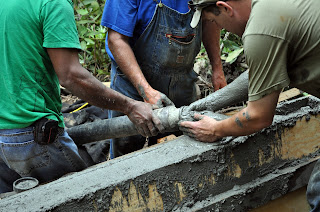In previous postings, Parts 1-3 I presented the beginning stages of construction. To follow the sequence begin here:
The wing forms have been built and added to the abutments.
This view illustrates the construction of re bar steel grid that adds strength to the concrete.
This view illustrates the wing form attached to the abutment
The footplate on the abutment is where the 50 foot bridge beams will be attached
These bolts were cast into the concrete of the abutment.
The falls above the bridge continue to inspire me and I do believe this will be a classic photo point along the MST in Watauga. Hopefully, the Friends of Watauga MST will be able to maintain and enhance this location for the enjoyment and appreciation of all hikers.
On this day it is evident how necessary a bridge is for crossing at this point along the MST. After an afternoon rain storm the water rushes to a depth of danger that makes it precarious to cross High Shoals Creek. This workers footbridge was quickly lifted and washed into the creek.
The photographer was not able to cross this day but you can see that the east side the wings have been completed in this shot.
Next work begins on the surface treatment of the exposed portion of the abutment.
Native stone is glued to the form and held in place until set.
Building upon each step the stone is put in place.
Finished surface stone work awaits final grouting.
The drain pipe is for back seepage to allow water to drain from behind the abutment.
Now the process of back filling behind the abutment begins.
Gravel is hauled by wheelbarrow and a base layer is filled to the drain pipe.
Corrugated and perforated drainpipe is put in place and attached to the spout.
After many loads of gravel, the trail is brought up to grade level.
Our contractor, Larry Hampton, was always on site and always keeping busy making progress on our project. Our Task Force director, John Lanman, had the highest of praise for the good work Mr. Hampton had done on this job. Thanks!



















































